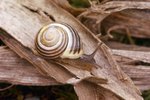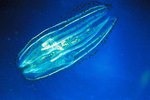You might think that the ability to reproduce without a sexual partner is consigned to the world of plants, fungi and single-celled organisms. But a few animals, the kind who walk and swim and fly, can reproduce without a mate. This process, called asexual reproduction, isn't necessarily common, but it does come in handy for some critters who might have trouble finding a date.
Marbled Crab
Marmorkrebs, which look like shrimp with tusks, are an asexual form of slough crayfish who live in Florida and southern Georgia, but they don't quite belong there.
The marmorkreb, whose name means "marbled crab" in German, is an invasive species who has set up populations in three countries while greatly upsetting native wildlife.
Warnings
Do keep marmorkrebs as pets in any outdoor tank. They will leave the water to cross land and invade new habitats.
Many jurisdictions regulate the import and release of various types of crayfish. In 2011, Missouri added marmorkrebs to its prohibited species list.
Marmorkrebs accomplish asexual reproduction via apomixis, a process usually reserved for plants in which an organism can generate an embryo without fertilization.
Whiptail Lizard
While most asexual animal species have a choice and only turn to asexual reproduction when needed, the whiptail lizard belongs exclusively to the girls-only club. This celibate, all-female species begins the reproductive process with twice the number of chromosomes as its sexually reproducing relatives. Whiptails evolved from hybrids of other species and may possess two complete sets of chromosomes.
Whiptails live in the Southwest, Mexico and South America and are the only known unisexual reptile.
Komodo Dragon
Despite some rather compelling reasons why komodos don't make great pets, including that their saliva is usually toxic, some people do keep these giant lizards in the home.
Concerns aside, female komodos have a singular ability to lay eggs without having had sex, and these eggs will produce healthy male children. This occurs because female komodos have two different sex chromosomes -- W and Z -- that multiply on their own in the eggs.
These eggs either become nonviable female WW or male ZZ, the presumption being that in an isolated environment, the female will create males with which to mate and, presumably, make more female komodos.
Captive Sharks
While not strictly pets, captive sharks have, even if only on rare occasions, reproduced asexually.
Female hammerheads captured as pups and kept away from males in Florida were the first known to do this -- and the discovery left mammals as the only vertebrates unable to give birth by parthenogenesis, or birth without sexual contact.
Ageless Hydra
The tiny and humble hydra is a favorite subject for scientists because it has one enviable, almost unique trait -- it shows no signs of aging. It also offers scientists a noncontroversial way to research human-beneficial stem cells.
But hydras have another unusual trait in that they can opt whether to reproduce sexually or asexually. When food is plentiful, hydras reproduce on their own; but when food becomes scarce, they mate with sexual partners to generate more diversity in the species.
Cloning Wasps
Asexual reproduction for wasps is complicated. When certain species become infected with Wolbachia bacteria, the chromosomes in wasp eggs change. As a result, the eggs do not divide, and instead of creating unique offspring, mother wasps create female clones of themselves.
While it sounds like a neat survival trick, the wasps are only buying time. Eventually the bacteria create only female clones who are infected.





